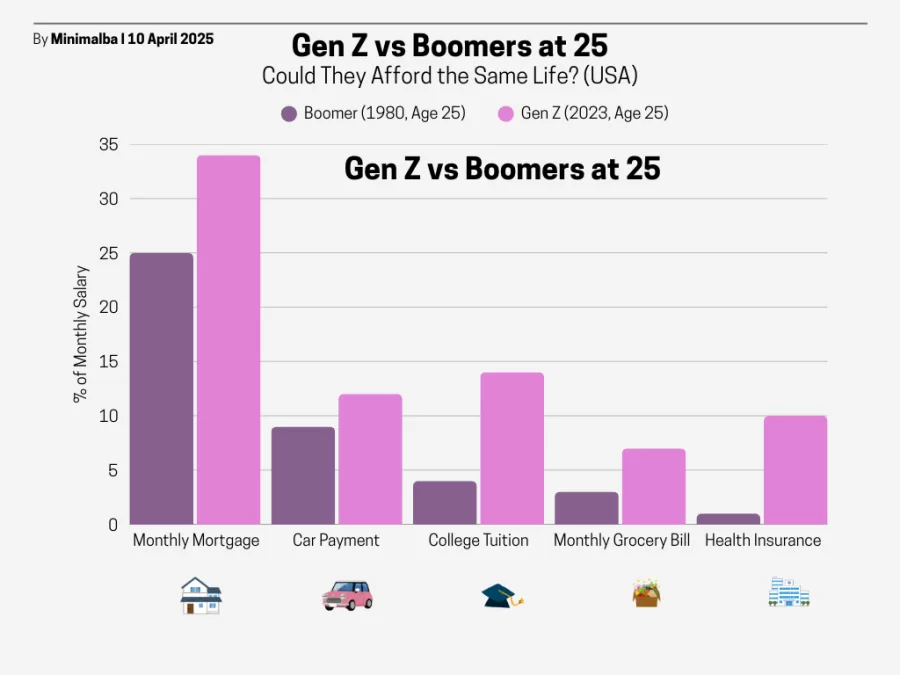Hello Cool-Girls ! Since the COVID-19 pandemic, we have been witnessing what could be called a clash of civilizations. It is not a matter of a clash between two cultures here, but rather a clear divide between two generations in the face of a struggle that of productivity. One of these civilizations literally came to fruition through this struggle, while the other questions its importance in favor of a softer life. But what is soft living ? Why do some criticize it so much, while others can no longer see beyond it ? In what way is the popularity of this lifestyle choice among Gen Z a symptom of the flaws in our system ?
1. The Broken Promise of Capitalism for Gen Z
1.1) From Pandemic to Economic Collapse
The soft living lifestyle was born in a time of crisis: first a health crisis, then an economic crisis, and finally an existential crisis. Generation Z (those born between 1997 and 2012) found themselves at a pivotal stage of their development during Covid. The youngest were just beginning to envision their future, while the oldest were entering the job market. Our ambitions were fueled by a narrative passed down by a generation that thrived and flourished under capitalism: the Boomers (born between 1946 and 1964). If you get a good education, you’ll land a well-paying job. If you work hard, you’ll be able to buy a house and go on vacation.
This narrative wasn’t a lie, since our elders accepted capitalism’s game in exchange for its promised benefits. But are those benefits still attainable today? To address this, let’s juxtapose the reality of a 25-year-old in 1980 with one in 2023 (see table below). According to a U.S. Census report, the median household income was $21,020 in 1980 versus $80,610 in 2023. So at first glance, purchasing power seems better now. But a deeper look at living costs paints a far bleaker picture:
- In 1980, the average monthly mortgage payment accounted for 25% of the median income, compared to 34% in 2023, based on historical mortgage rates from the Federal Reserve (FRED) and income data from the U.S. Census Bureau.
- The average monthly car payment for a new vehicle was approximately 9% of median income in 1980, based on vehicle pricing from a 1980 Ford Mustang ad, and around 12% in 2023, according to Kelley Blue Book and FRED income estimates.
- Groceries for one person took up 3% of monthly income in 1980, rising to 7% in 2023, based on food expenditure data from the USDA.
- For education, in 1980, the average annual tuition at a 4-year public university was just 3% of the median income, according to NCES data. In 2023, it’s more than 14% (College Board, 2023).
- Finally, estimated monthly health insurance premiums per person grew from 1% of household income in 1980 to 10% in 2023, according to data from CMS, and the Kaiser Family Foundation (KFF).

1.2) Why the Numbers Don’t Add Up
Between 1980 and 2023, the cost of living in the U.S. skyrocketed, mirroring trends across much of the world.
While incomes grew 3.8× nominally, real living costs rose even faster, especially when accounting for modern necessities like smartphones, internet, insurances and childcare. Even excluding those, the core essentials : housing, healthcare, college tuition and transportation; in 2023 consume 77% of median household income, up from just 42% in 1980.
In other words, despite higher earnings, real purchasing power has eroded dramatically across generations.
To truly understand why Gen Z embraced ‘soft living,’ one must first grasp the brutality of these numbers. For much of Gen Z, entering adulthood means facing systemic financial instability. It is a stark contrast to previous generations who traded their time and health chasing material wealth as markers of success.
So why would today’s youth make that same sacrifice, only to inherit insecurity and deteriorating well-being?
2. What Is Soft Living? Why Gen Z Chooses Happiness Over Hustle
2.1) The Death of the Middle Class: Why Gen Z Can’t Play by Old Rules
The economic context created fertile ground for young people to adopt a new lifestyle. With growing inequality, markers of success are becoming increasingly out of reach, the middle class is disappearing. We’re heading toward a society with just two classes: those who own everything and those who own nothing. But this wasn’t the only factor behind ‘soft living.’
Young people today are also more educated about capitalism’s harmful effects on the environment and on our physical and mental health. We’ve become “woke”; much to the regret of some.
It’s only natural then that the generation facing this new reality would redefine success criteria and use the means at their disposal to do so. This is what we’re seeing with the development of soft living. What do young people today actually possess? Their time and their health. They will redefine their success around these elements.
They are allocated to:
- spending quality time with family and friends
- cultivating hobbies
- traveling
- living your dreams
- taking care of physical and mental health
- exercising
- or devoting themselves to personal development
These activities are now ‘high rewarding’ while ‘climbing the corporate ladder’ is ‘low rewarding’.
2.2) What is Soft Living : The New Success Metrics for Gen Z
So what is slow living ? It’s using your work income as a means to fund your life rather than as a reason to live. It means stopping the chase after material success that you’ll never achieve in a healthy way and directing your energy toward what makes you happy.
It’s not about stopping work altogether since having an activity can bring a form of fulfillment and thus contribute to your happiness. But work must integrate into a life balance that includes : your social life, daily rest, personal fulfillment, hobbies and mental health.
So what is slow living ? It’s using your work income as a means to fund your life rather than as a reason to live.
This new lifestyle goes against all the values that shaped previous generations. Those who took pride in their hard work and believed that ‘work equals health. That’s why Gen Z is called lazy. But are they lazy or pragmatic?
Soft living doesn’t appear to be a passing trend, other societal movements align with this philosophy like the Great Resignation, which began in 2020 during the COVID crisis, or quiet quitting, which went viral on TikTok in the summer of 2022. These phenomena are symptoms of a sick society, and for many, soft living is the remedy.
The reality is that capitalism, like a steamroller, tries to extract the last drops of profit from workers. Every generation is exhausted, as seen in the rise of burnout and, consequently, soft living’s growing popularity across age groups. This isn’t a rejection of work, but an awakening to exploitation, proven by hard data. The question isn’t why Gen Z embraces soft living; it’s why anyone still expects them to play a rigged game.
Data Sources
- U.S. Census Bureau – Historical Median Income Data
- FRED (Federal Reserve Economic Data) – Mortgage Rates & CPI Data
- Kelley Blue Book – Used for car pricing trends
- 1980 Ford Mustang Ad – Sourced from historical ad archive
- NCES – Tuition Cost Tables (1980)
- College Board – Trends Report 2023 – PDF Download
- USDA – Historical Food Spending – Food Expenditures Data
- KFF State Health Facts – Health Cost Stats





